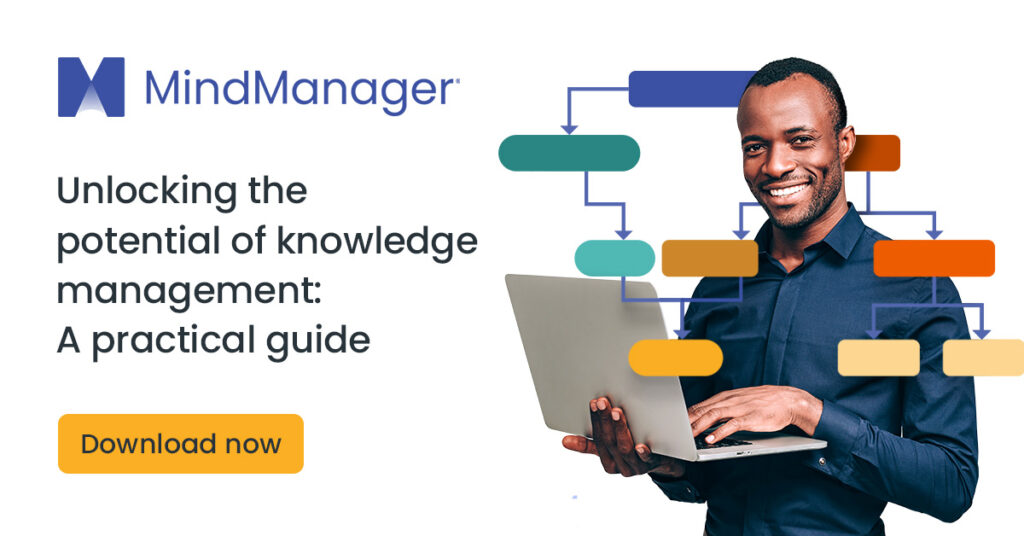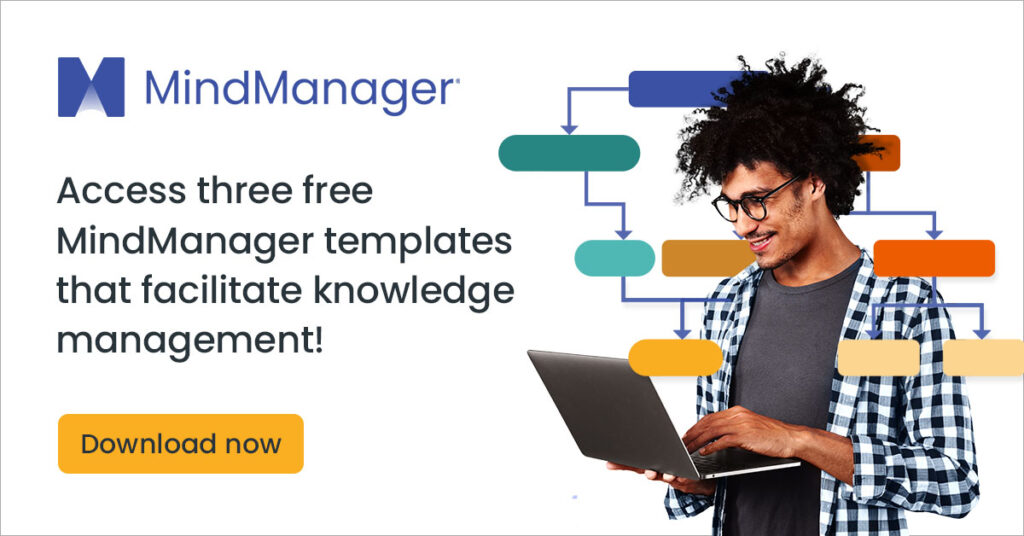Knowledge management (KM) is the practice of capturing, curating, organizing, and sharing information and resources within an organization. It involves utilizing different techniques and technologies to ensure that data is properly stored and easily accessible at any point.
Knowledge management can help deliver more effective project results by providing the necessary information and resources needed to successfully complete a project. Moreover, knowledge management tools, such as MindManager®, enables teams to access best practices, tips, and techniques to speed up the completion of projects.
Knowledge management tools help organizations achieve better project results by enabling teams to plan, track, and coordinate tasks in an organized and efficient manner. By sharing documents, ideas, and resources, teams can better collaborate and work towards their goals on any given project. This is crucial for knowledge sharing and knowledge transfers.
Using MindManager, you can organize and brainstorm every step of your project to ensure you and your team stay on track. In addition, you can specifically use it to transfer knowledge management skills within your organization via diagrams, charts, and maps. Our workbooks and mapping templates can be used to enhance your organization’s specific approach to project management.

4 Benefits of using knowledge management to complete projects
There are many reasons why organizations use knowledge management to stay on top of their project efforts. Some of these benefits include:
1. Streamlining of processes
Knowledge management can help you streamline processes by creating a centralized environment for:
- Communication
- Organizing teams
- Managing tasks
- Brainstorming
Project teams can improve overall efficiency and productivity by setting up automated workflow patterns and improving visibility across departments directly on mind maps. Using MindManager, you can make essential aspects of your project stand out. Our knowledge management capabilities make it simple to create organized plans and carry out processes essential to your project.
2. Improved collaboration during the knowledge capture process
Knowledge management makes it easier for team members to collaborate on projects. Tools, such as mind maps, can provide an organized platform for sharing documents, tracking progress, and assigning tasks seamlessly.
In addition, MindManager’s maps can be easily embedded in other documents. You can also link to or attach files directly in the mind maps themselves. This enables teams to share key information where it is most directly relevant.
3. Increased visibility into organizational knowledge
With knowledge management tools, project managers have all the data and metrics they need in a centralized location so they can quickly identify issues or track changes that might impact the project.
This visibility helps them avoid potential delays or cost overruns while delivering better results within their deadlines. MindManager’s software supports increased visibility into organizational knowledge, so vital company data can be utilized whenever necessary.
4. Optimal resource utilization
As a project manager, you need to ensure the optimal use of resources through proper task assignments, resource scheduling, and workload distribution. This helps organizations optimize resources while staying within budgets with minimal wasted efforts and money.
With MindManager, you can create workbooks with different pre-built templates, such as the Coaching Map and Working Map, which can help you to capture project information and processes, while improving knowledge management. These can prove to be valuable resources and help you and your team to tackle future projects more efficiently.
Types of knowledge management diagrams for projects
MindManager’s knowledge management tools are often used to help with project planning and task management. Mind maps can help you to seamlessly map and visualize workflows, processes, and project responsibilities.
They also provide a visual overview of all the critical project details. You can utilize MindManager’s Generic and Small Project Maps and Workbooks to enable you to capture, relay, and organize project documents and processes.
Some MindManager maps that can help enhance knowledge and project management include:
Swimlane map: Swimlane maps show the steps of a project and who is responsible for each step. Swimlane maps use rows or columns to represent each stakeholder. You can use a swimlane map to create a detailed breakdown of responsibilities.
Value stream map: A value stream map includes the duration of each step in a project and additional details about materials, inventory, and other relevant information. Value stream maps are typically used to show the steps of a production process, including how long each step takes and how much product is being handled at each stage.
Spider diagrams: Spider diagrams take a central idea or focus question in the center, with topics branching out radially. Spider maps work best when exploring and brainstorming various facets of one central concept within a project.
Gantt charts: Gantt charts are useful for planning and scheduling projects. They make it easy to monitor progress and hold team members accountable for their contributions. In addition, they let you look at the overall project timeline, with tasks visually represented and responsibilities allocated to various team members using labels or color-coding.
Tree diagrams: A tree diagram enables users to visualize possible outcomes and probabilities for a given situation. These are particularly useful in charting the results of dependent events within a project, where if one element changes, it impacts the entire outcome.

How does knowledge management go hand-in-hand with project management?
Knowledge management improves project management within an organization. For example, you can use MindManager’s maps, templates, and workbooks to help you capture all steps of your project’s process. This makes future projects and endeavors easier to accomplish, and facilitates knowledge management within your organization.
Knowledge management becomes easier when you implement tools to help you organize and capture project information, or support “learning by doing”. Furthermore, you can set your projects up for success by ensuring that the right tools and processes are available at the right time.
Lastly, knowledge management promotes effective information sharing and improves the quality of decisions. Hence, putting the right processes and tools in place can help you achieve better work and more successful projects.
For more information on project management and knowledge management and a deeper dive into how MindManager can enhance both at your organization, access our free e-book or free webinar today!

